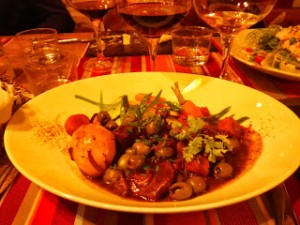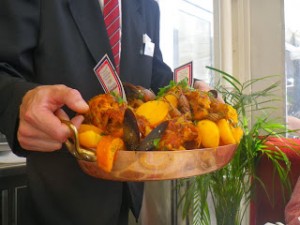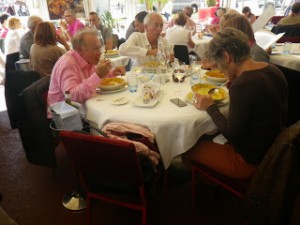Eating eel and bull meat a Provencal treat in France
 |
| Ingredients for bouillabaisse are sold at the waterside morning fish market in Marseille |
Eating in France is always an adventure and regional specialties help to underscore the sense of place. Bouillabaisse, which originated among fishermen as a way to use some of the catch not easily sold, was something I enjoyed at Miramar, just steps from the morning fish market on the waterfront of Marseille.
Bouillabaisse includes conger eel, spiny red hog-fish and gurnet for starters, with sea bass, red mullet, monkfish and some crustaceans cooked together
quickly in a mixture which sometimes includes sea water, or white wine.
Seasonings include saffron, which gives it a lovely orange color, onion, tomato, thyme, garlic, sage, fennel and a slice of orange peel with maybe glass of cognac for good measure. Every place has its own version and fans which claim it as the best. But, in my opinion, Miramar is state of the art.
A paste of hot Spanish peppers and toast, served alongside it, is meant to sharpen the sauce.
In France the bouillabaisse is served in two courses. The first is the broth in which the fish are cooked for about 10 minutes. Some spread the toast with the pepper paste and place it in the bowl before the broth is poured over it.It’s eaten like soup using bread on the table to sop up the last taste. Then the fish, which has been placed in a separate dish, is eaten. To judge by the silence that falls over an animated table when the dish is served, people in Marseille take their bouillabaisse very seriously.
In Arles, one of my favorite cities in Provence, bull fighting has a long tradition and bull’s meat stew with olive was on the menu for dinner at Le 16. Bull fights, which take place in spring and in fall in the 2,000 year old Roman arena in the
center of town, do not result in the bull being killed, as is the case in Spain. Instead the matador plucks a ribbon from in between the bull’s horns — a dangerous proposition to be sure.There’s also a running of the bulls in the streets of Arles, but the horns have balls placed over their ends to lessen the danger.
The bulls come from the Camargue, a nearby delta in southern France where two branches of the Rhone River meet the sea. The bulls roam freely on the grassy marshland, as do the striking white horses which also live here.
 A good fighting bull can live and fight for a decade before it becomes dinner.
A good fighting bull can live and fight for a decade before it becomes dinner.
Bull’s meat stew was my dinner in Arles. I was the only one in my group of six to order the bull’s meat stew, but I found it to be delicious. I will be making my next beef stew with olives.
p.s. Click on the restaurant links above to go to the web sites for these great places. Then you will see their menus, be able to make reservations and enjoy the food for yourself.








Recent Comments